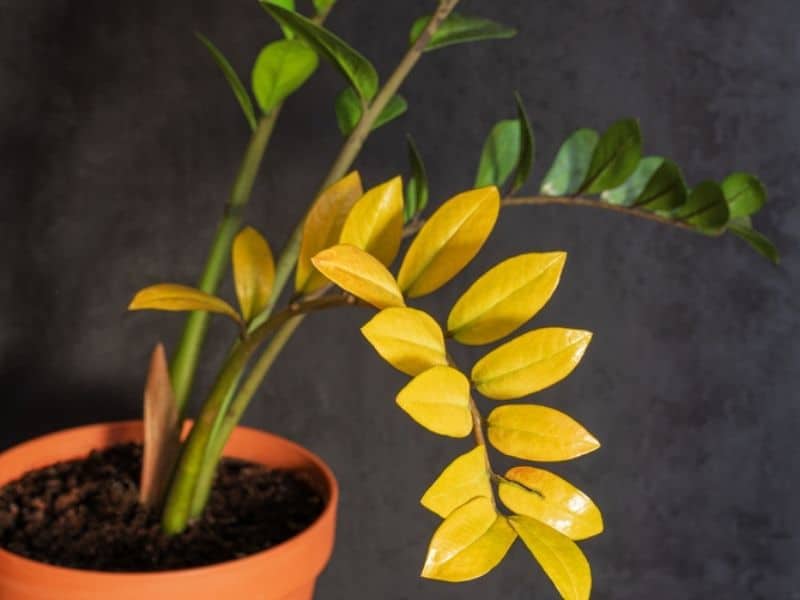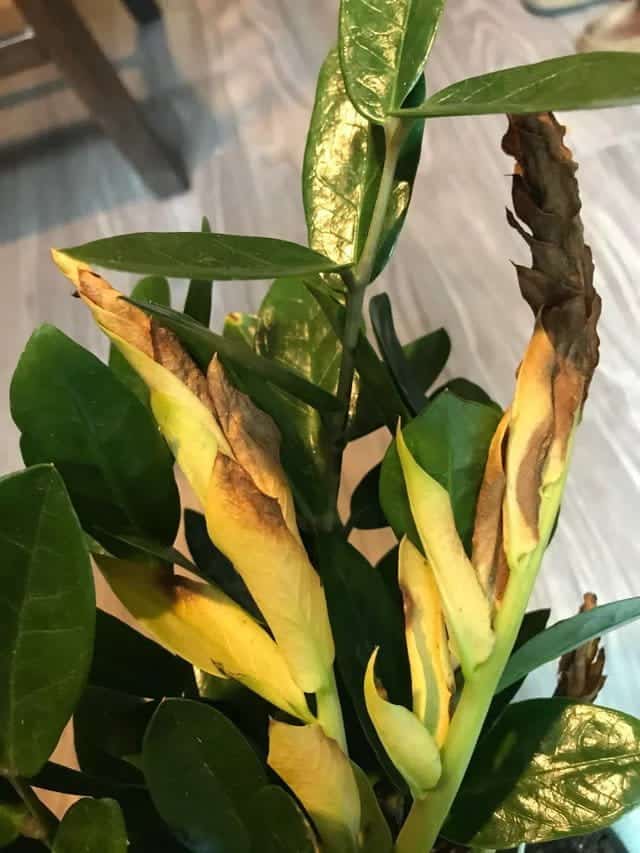ZZ plant (Zamioculcas zamiifolia) is native to the tropical forests of Africa. The characteristic of the ZZ plant is that it prefers indirect sunlight, does not need frequent watering, and grows slowly.
Therefore, many people choose this plant to make bonsai in the home or office. The process of taking care of the ZZ plant does not take much effort and time.
However, one of the problems that most people can have is over-watering the ZZ plant. Over-watering will cause many serious consequences and if you do not detect it early, plants will die.
So, we need to learn about the signs of the ZZ plant being over-watered and how to fix it in this article.
Overwatered ZZ plant – Here is why?
ZZ plant does not need daily watering in large amounts. This plant is very drought tolerant. Therefore, you can not water the ZZ plant for about 4 weeks and it can still grow.

The reason is that the roots of this plant are like small potatoes, they are responsible for storing water and will use it gradually. So the ZZ plant is not a shallow-rooted plant and you have to provide it with water every day.
Some of the reasons for you to overwater this plant include planting material,
Materials for planting
Usually, people will grow ZZ plants in plastic trays, styrofoam containers, or pots in the room or workplace. The characteristics of all these materials are poor drainage and easy soiling.
In particular, many people are afraid of water spilling on the table or house, so limit the drainage holes on the basin or bucket. This makes it even more difficult to drain excess water.
So, if you accidentally water the ZZ plant more, the soil will not be able to drain water on its own.
From there, the water will be completely trapped in the pot, and the plants will be flooded, lack oxygen, and can not absorb nutrients. Since then, the roots of the ZZ plant have to work too hard leading to damage and root rot.
Poor soil composition and not draining
Poor soil composition will also make drainage more difficult. ZZ plant can live in almost any soil, however poor soil mixes will also cause frequent waterlogging problems.
The best soil composition for ZZ plant growth is sand, perlite, or a pre-mixed soil mix. The ideal pH is between 6.0 and 7.0.
Unscientific watering schedule
Watering for any plant should be based on its water consumption characteristics. ZZ plant is a plant that does not like too much water per day. So you need to build a consistent watering schedule instead of inspired watering.
Your watering schedule can also be altered by many factors such as weather, humidity, or water availability. So you can water more ZZ plants causing the amount of water to exceed the standard.
You need to check the moisture in the soil with your hand or a moisture meter before watering.
The rule of thumb for watering a ZZ plant is 1 or 2 inches above the surface of the dry soil. Alternatively, you can check by lifting the pot and inspecting the bottom soil. If it is dry, add more water to the ZZ plant.
Signs of an overwatered ZZ plant
When you water too much, the ZZ plant will emit several signals for help both on the stem, leaves, and roots. It is important that you observe carefully and fix it early or the plants will die.
Leaves are turning yellow or brown
One of the early signs you can spot about overwatering is the yellowing or browning of leaves.
This is a sign that the roots have been overloaded, and unable to absorb oxygen and nutrients, making the leaves unable to photosynthesize as usual.
The chlorophyll in the leaves will be lost causing the green color to turn yellow or brown. Leaves are also drooping, soft, and gradually falling off.
This phenomenon will occur simultaneously instead of each old leaf turning yellow as usual. At the same time, you can also observe black spots on the leaves because it is also a warning sign of excess water.
Stems are soft, and brown spots appear
The trunk of the plant from receiving too much water makes it soft, weak and bent down. The stem will also appear brown and black spots due to harmful bacteria that have attacked and destroyed it from the inside.
You may see the stems change color to brown and no longer be the light green or white color they would have been during their healthy period.
Root rot, stem and leaf rot
Finally, the most obvious sign of overwatering a ZZ plant is root, stem, and leaf rot.
If you find that the roots of this plant are rotten, the chances of saving it are very low. Root rot is a phenomenon where the roots are soft, mushy, and have a rotten smell due to the attack of harmful bacteria.
Waterlogged roots make it impossible for the roots to exchange oxygen as well as absorb nutrients for the stem and leaves. You can detect root rot if the base shows signs of humus, paste, and rotten smell.
Read also: ZZ Plant Misting – Is This Necessary And Effective?
How to save the life of an overwatered ZZ plant?

Before learning about the steps to save the life of a ZZ plant spill, it is important to assess the extent of the damage to the roots. If the ZZ plant’s roots are completely rotted and don’t have any healthy branches, you can’t resurrect it.
However, if you find some roots that are white, hard, and don’t smell rotten, then you can take steps to save them.
Revive the ZZ plant at a mild level
If your ZZ plant is flooded in a short time and you detect it in time, you can put it in a place with lots of light. Although these plants do not like direct sunlight, when they are over-watered, soft light will help them solve this problem.
Light will make the leaves and soil dry faster, and promote the evaporation of moisture from the leaves, stems, and roots. Photosynthesis is also faster, so ZZ plants can synthesize natural sugars for the entire stem and leaves.
You can place the ZZ plant near a window about 1 meter away to receive indirect light every day. This will help the soil dry out faster and you only need to water it again when the soil is dry.
Reviving ZZ plant in severity
The severity of over-watering is root rot. Let’s follow the steps to save the life of the ZZ plant as follows:
Step 1: Gently remove the plant from the pot. Avoid using a knife to break its roots. Be patient and dig slowly to remove all the roots from the soil. If the roots are too rotten, they won’t stick to the soil, so you can easily remove them.
Step 2: Check and classify the rotten and healthy root branches to continue replanting. You can use clean water to remove some soil and humus. Roots that have softened or turned brown should be removed with clean scissors.
You just need to keep the roots that are white, hard, and healthy. You also need to remove white or brown mulch or mulch because fungal spores can attack again as they mature.
If the stem and leaves are completely rotten or lifeless, you can remove them completely. You just need to keep the healthy root branch, the stem will grow back quickly and produce many healthy leaves.
Step 3: You should not replant the ZZ plant in the old pot right after. You must clean the pot and change the old soil mixture. This is because old pots and soil can harbor harmful fungi and bacteria.
They will hide in the old soil and continue to attack the ZZ plant when you replant. Therefore, it is best to keep this plant in a new pot with drainage holes. Then you change the new soil with a soil mix with the ideal pH.
Step 4: After trimming the rotten stems, leaves, and roots, you can treat the fungus with a fungicide to protect the roots and help it quickly re-grow. For slightly rotten branches, you can sprinkle cinnamon powder on the roots.
Cinnamon powder also contains natural ingredients that help kill mold and stimulate the re-growth of the root system.
Step 5: You replant the roots into a new pot and place them in a place with indirect sunlight every day. In the coming days, you do not need to water the ZZ plants because they need time to drain moisture and re-balance the water.
You should only water again when the soil has dried using a moisture meter or finger to check.
Conclusion
Too much watering will cause many serious consequences for the ZZ plant if you do not detect it early. Signs of overwatering are easy to see such as yellow, brown leaves, black spots on leaves and stems, soft stems, hummus, and rotten roots.
To revive a ZZ plant, you must assess the extent of the damage to the roots. You can not save it if the roots are completely damaged and stink.
If the ZZ plant still has some healthy roots, you can replant them to revive them. However, you need to ensure hygiene such as clean scissors, and clean pots and soil before replanting.
Keep in mind that fungal spores can appear everywhere in old pots or old soil. Therefore, you should cleanly remove harmful fungi and bacteria with a fungicide or cinnamon powder before replanting.
Do not forget to use gloves during this process because the ZZ plant is poisonous, so it can affect the health of people and pets.